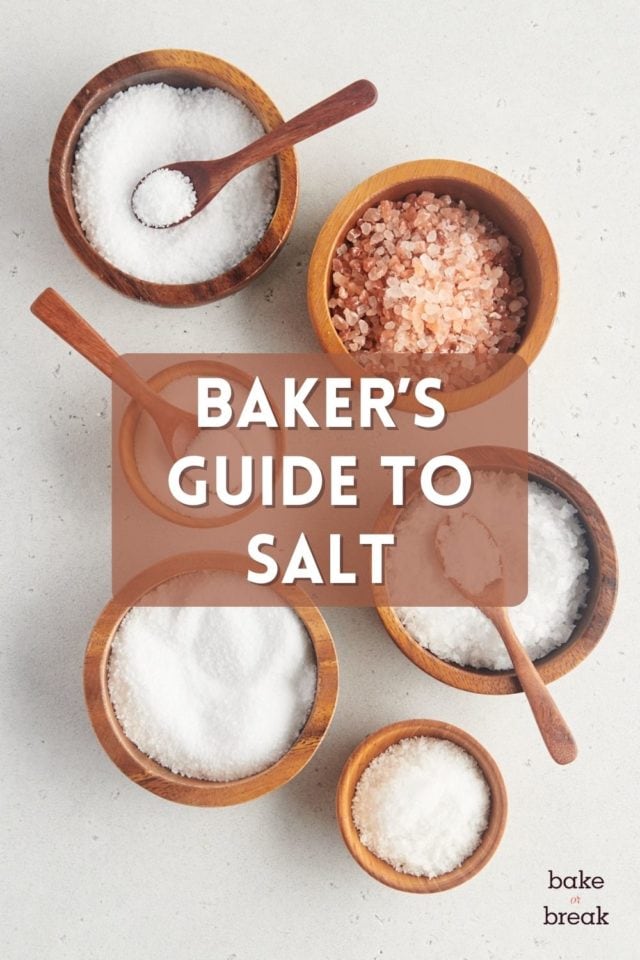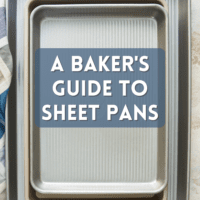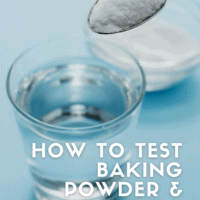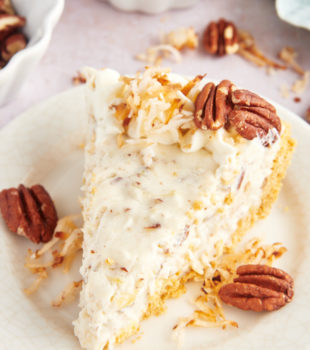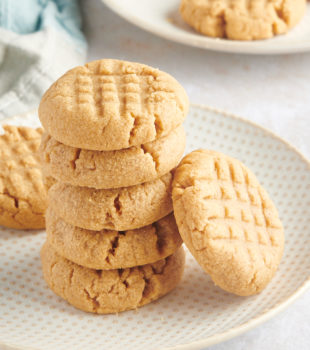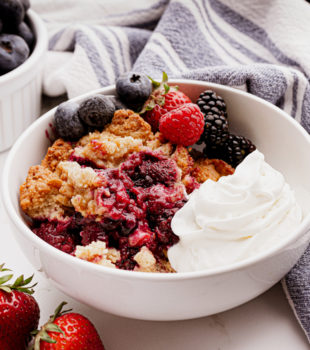Salt can get a bit overlooked in baking, but it’s actually a crucial ingredient. This humble seasoning does more than just enhance flavor; it’s a game-changer in the baking world!

Have you ever bitten into a seemingly perfect cookie only to find something was missing, but you couldn’t quite put your finger on it? The secret ingredient that often goes unnoticed but makes all the difference is as simple as it is essential: salt.
Salt is the backbone of balancing sweetness and bringing out the depth of other flavors in baked goods. And when it comes to bread baking, it strengthens gluten structure for better texture and regulates yeast fermentation to ensure the perfect rise.
Let’s dive into the surprising world of salt and discover how this basic kitchen staple is the unsung hero of delicious baked goods.
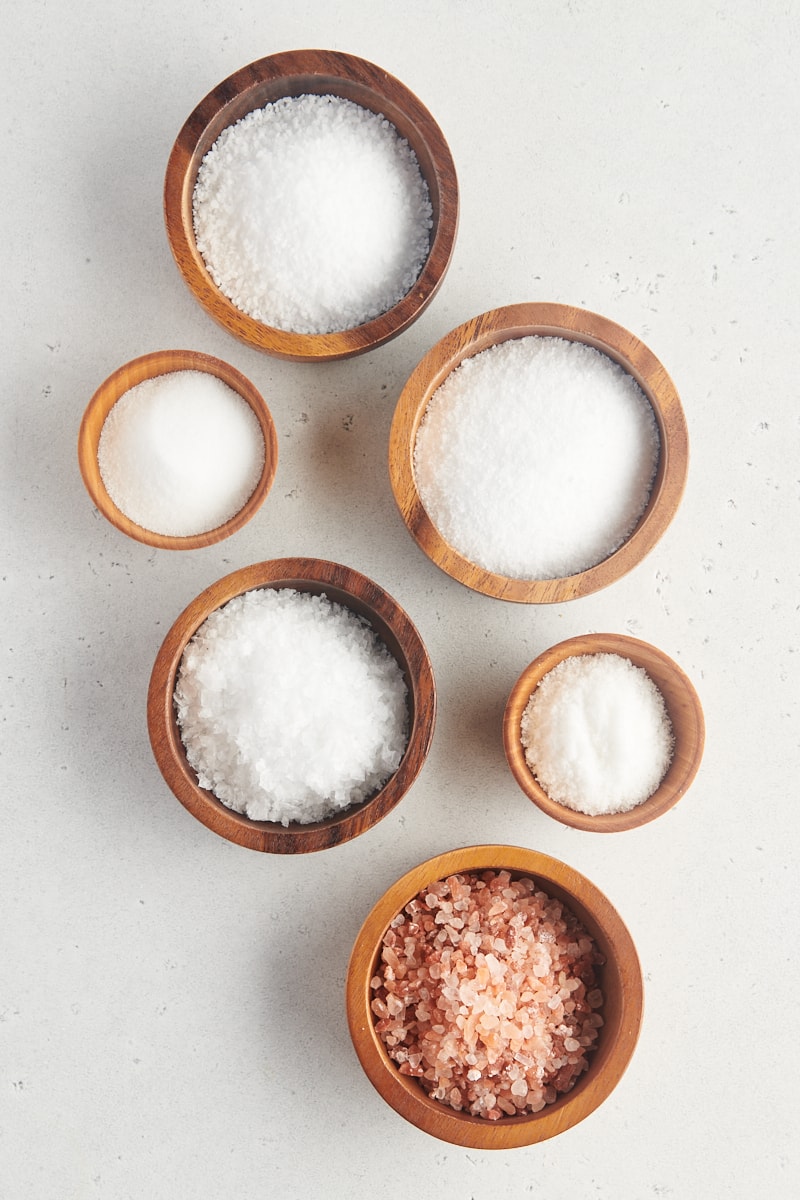
What Salt Does in Baking
Salt wears a few different hats when it comes to baking. Let’s take a look at the main roles that salt plays.
Flavor enhancer
For most home bakers, the primary use of salt is flavor. More specifically, we mostly use it as a flavor enhancer. It serves to balance sweetness and reduce bitterness. Beyond balancing sweetness, salt plays a pivotal role in elevating the natural flavors of ingredients, making chocolate richer, vanilla more aromatic, and buttery notes more pronounced. It unlocks the depth of flavors in baked goods, ensuring that each bite delivers a full spectrum of taste sensations.
Dough strengthener
Salt is essential in baking breads and pastries to strengthen the gluten in those doughs. This helps those baked goods rise nicely and have the proper structure.
Yeast controller
All you bread bakers out there know that salt is one of the four basic bread ingredients. Its elite spot on that short list is because it works to control yeast fermentation, preventing over-proofing and ensuring the proper rise.
Preservative
Because salt is hygroscopic, meaning that it attracts water, it helps to keep your baked goods fresher longer. It not only attracts water but also helps to slow down the spoilage process by reducing the moisture available for microbial growth.
Types of Salt Used in Baking
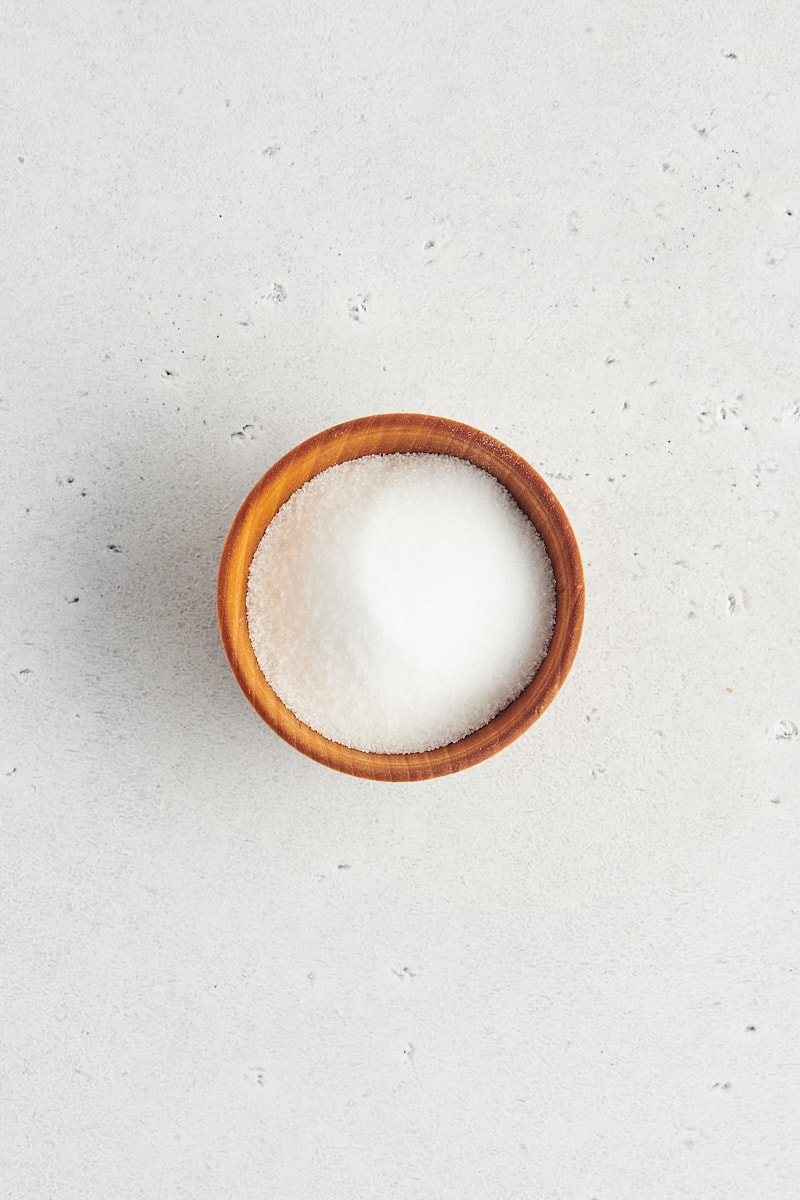
Table Salt
The most common type of salt for baking is regular table salt, which is characterized by its fine grains. It can be iodized, which some think gives it a chemical flavor.
The fine grains of table salt dissolve easily and distribute evenly throughout the dough or batter, ensuring a consistent flavor in every bite. This makes it ideal for recipes where precise salt distribution is crucial, such as cakes, cookies, and breads.

Kosher Salt
Kosher salt gets its name from the use of its large flakes to treat meats to make them kosher.
You might opt for kosher salt in recipes where the coarser texture and flakiness can add a desirable crunch or when you’re looking for a less intense burst of saltiness, given its larger grain size. Kosher salt is also often preferred for its pure, clean taste, as it usually doesn’t contain additives like iodine, which some believe can impart a slight chemical flavor.
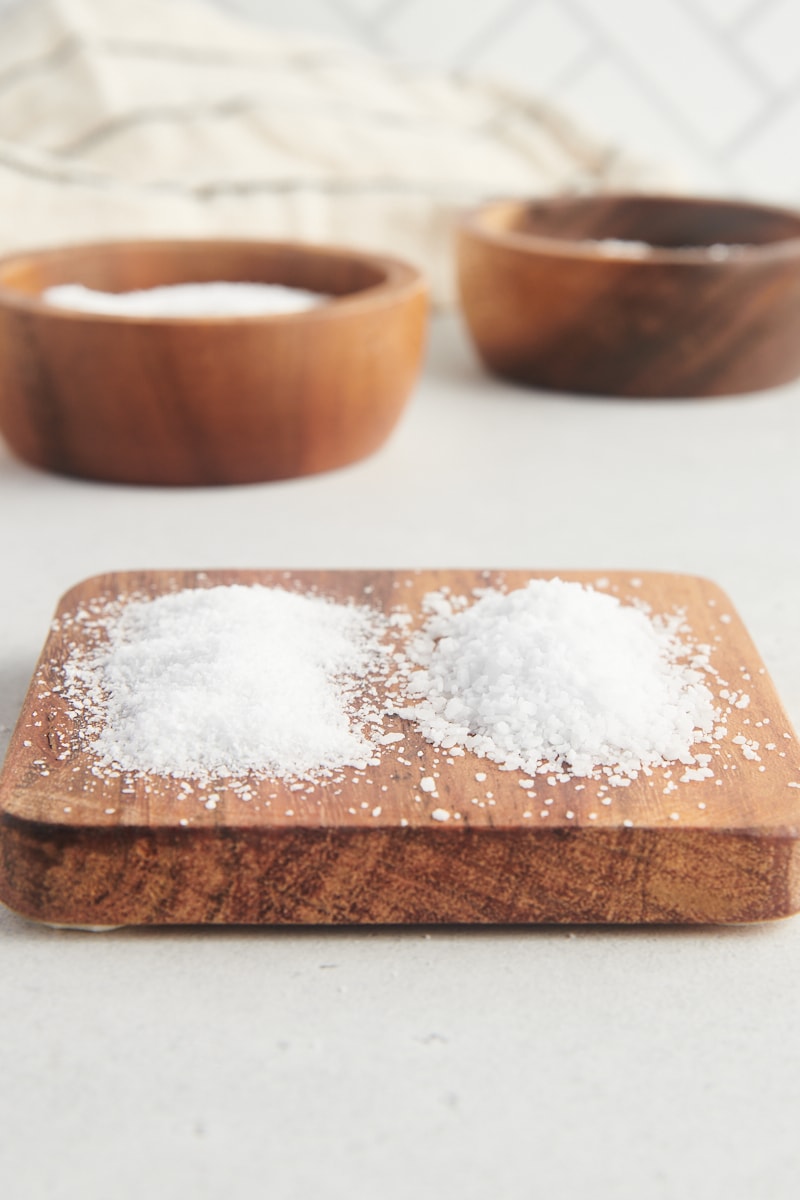
Morton Kosher Salt vs Diamond Crystal Kosher Salt
Using kosher salt comes with a caveat, however. The thing to remember is that not all kosher salts are the same. There can be variations in their crystal sizes from one brand to another. In particular, two of the more readily available brands – Morton and Diamond Crystal – have enough differences to affect how you should use them.
- Grain Size and Shape: Diamond Crystal kosher salt has a lighter, flakier structure with larger, hollow crystals. Morton’s kosher salt has smaller, denser grains. This difference in texture means Diamond Crystal dissolves more quickly and adheres to food surfaces differently than Morton’s.
- Volume vs. Weight: Because of their structural differences, the same volume of Morton’s and Diamond Crystal will not weigh the same. Morton’s is denser, so a measured volume of Morton’s kosher salt will weigh more than the same volume of Diamond Crystal. This is crucial in baking, where precision matters. If a recipe specifies kosher salt but doesn’t indicate the brand, this variance can affect the outcome of the recipe.
- Measuring and Substituting: When substituting one for the other, it’s important to go by weight, not volume, for accuracy. If a recipe calls for 1 teaspoon of Diamond Crystal kosher salt and you only have Morton’s, you’d use less Morton’s to achieve the same effect because of its greater weight per volume. For instance, if a recipe calls for 1 tablespoon of Diamond Crystal kosher salt, which weighs about 9 grams, and you only have Morton’s, you would use about 3/4 tablespoon of Morton’s kosher salt to match the same weight because Morton’s is denser. This ensures that despite the difference in crystal size and shape, the saltiness of your dish remains consistent.
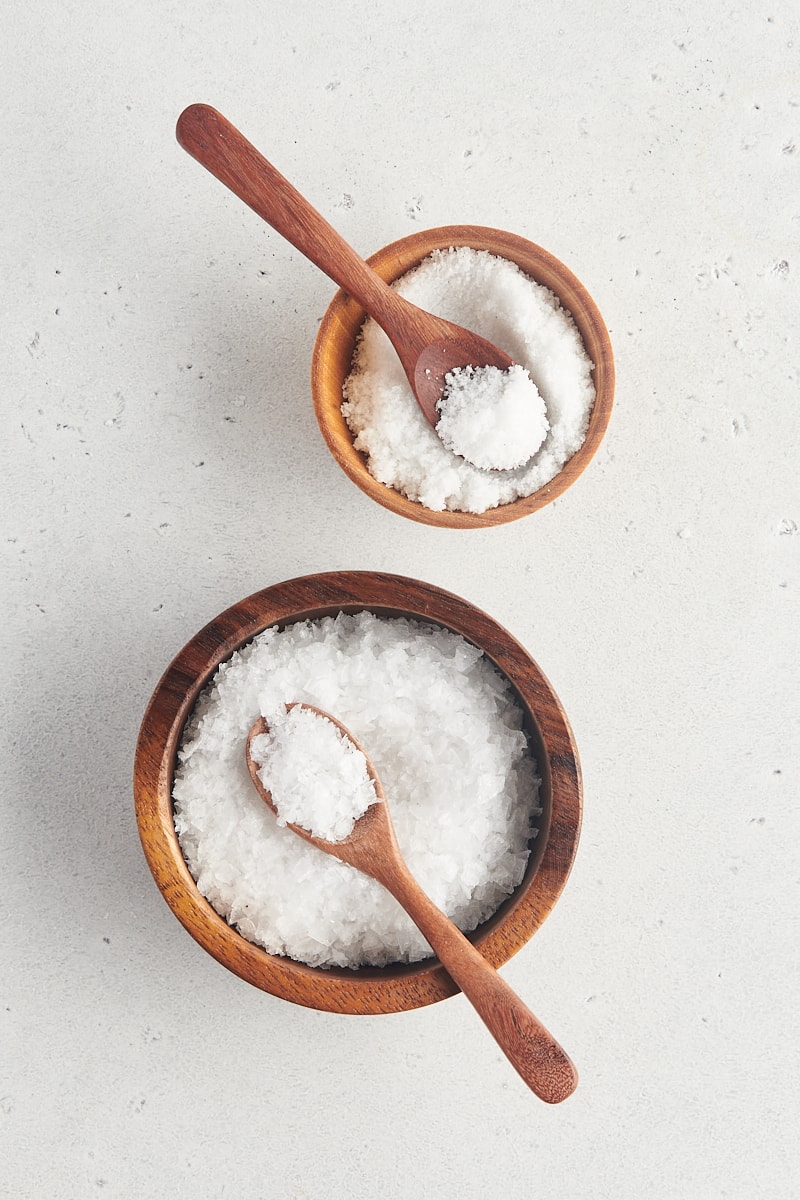
Sea Salt
You’ll find sea salt in various textures from fine to coarse. It can also contain minerals that can add subtle flavor. In baking, it’s most often used as a finishing salt for texture and flavor on top of baked goods, like salted brown butter chocolate chip cookies and salted fudge brownies.
Fine sea salt is like its coarser version but with grains comparable in size to table salt. Because of that, it dissolves easily in batters and doughs. All of that means that it can usually be substituted by volume 1:1 for table salt in baking recipes.
The unique mineral content of sea salts can subtly affect the flavor profile, adding a layer of complexity to simple recipes. Just keep its mineral flavor in mind when using it, especially in simple recipes with few ingredients.
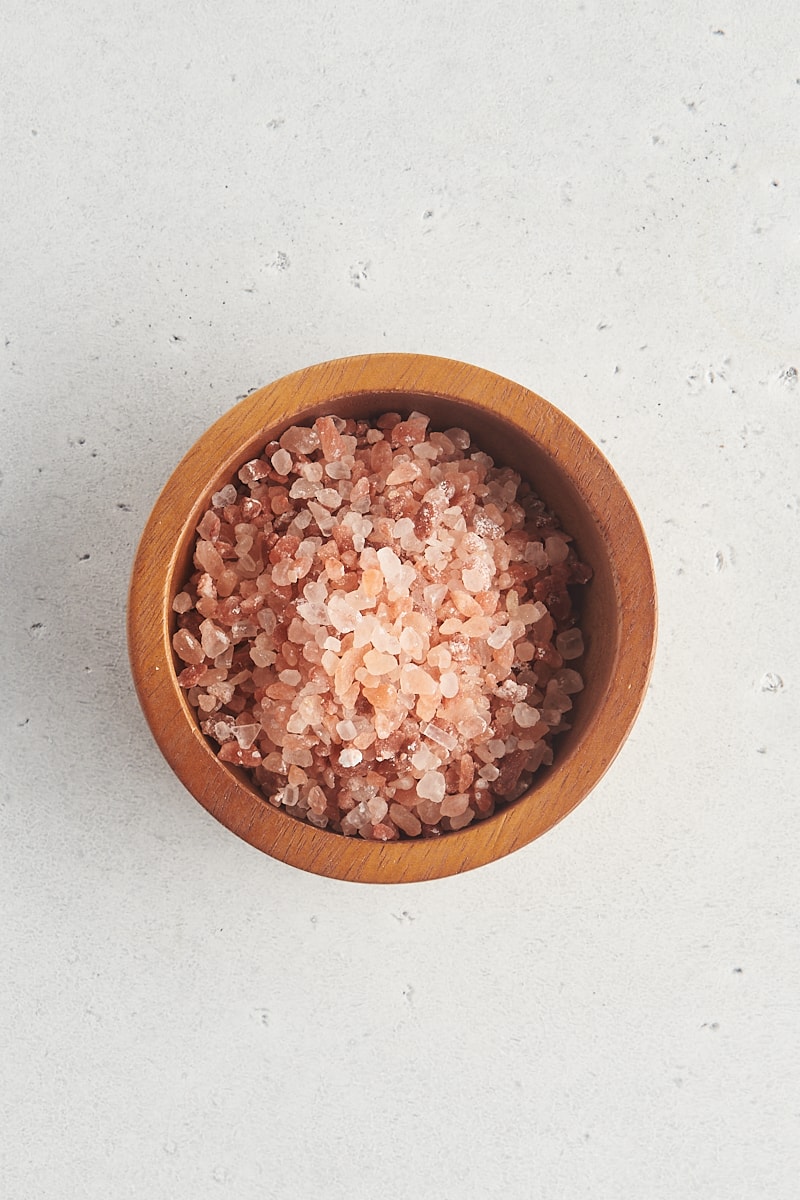
Himalayan Pink Salt
The trace minerals found in this salt give it a characteristic pink color. This pretty salt is best used as a decorative finish.
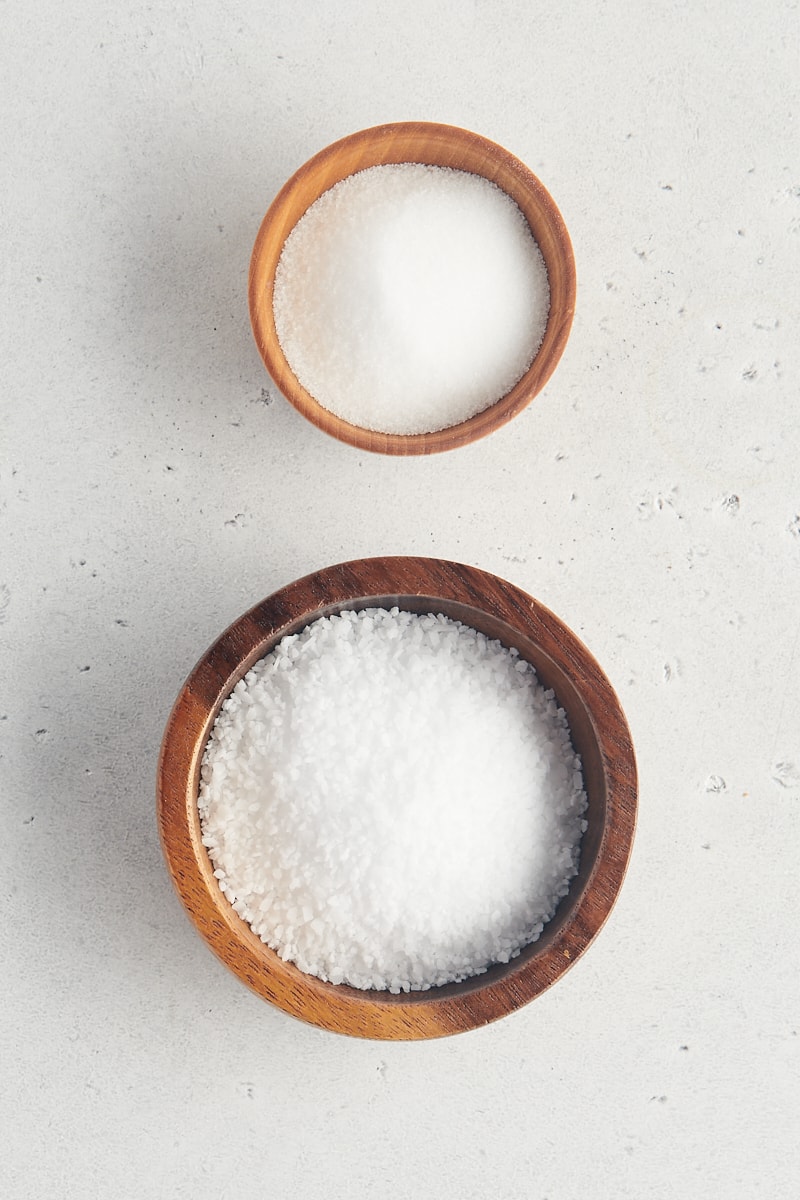
Table Salt vs Kosher Salt
I’m often asked about whether it’s better to bake with table salt or kosher salt. In most cases, my preference is table salt. However, you can use either as long as you understand how they each affect your baking.
Grain Size
The thing you’ll first notice is the different size of the grains. Table salt has a fine grain, while kosher salt has a coarser grain. That difference isn’t just cosmetic; it also affects measurement. The finer grains of table salt will pack more tightly in a measuring spoon. This means that if you use a volume measure (like a teaspoon or tablespoon), the same volume of table salt will weigh more and thus be saltier than an equivalent volume of kosher salt.
How to Substitute
To accurately substitute one for the other, you often need to adjust the volume used: for instance, you might need about 1.5 to 2 times the amount of kosher salt as table salt to achieve the same level of saltiness in a recipe. This ratio can vary based on the recipe and personal taste, so it’s wise to start with a lower amount and adjust as needed.
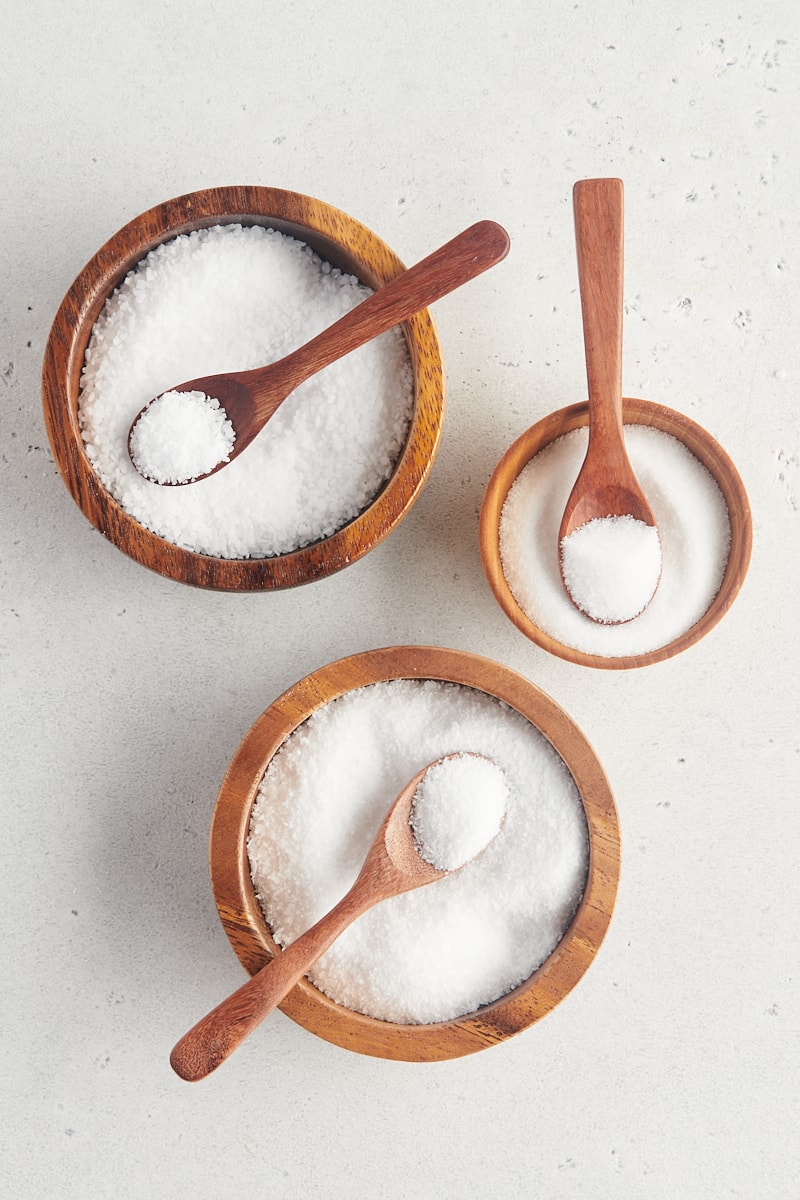
Substituting Salts in Baking
When precision is key, measuring salt by weight rather than volume can significantly improve the accuracy of your recipe adjustments. However, you’ll find that most recipes don’t provide weights for small volume ingredients like salt. But understanding the general principles of how these salts compare can help you make more informed substitutions. Here are some general guidelines for substituting:
- Table Salt and Fine Sea Salt:
- These can generally be interchanged 1:1 by volume due to their similar grain sizes and densities. However, because fine sea salt may have slightly larger crystals and potentially contain trace minerals, start with equal amounts and adjust to taste if necessary.
- Table Salt to Kosher Salt (and vice versa):
- Since kosher salt grains are larger and less dense, you’ll need more kosher salt by volume to match the saltiness of table salt.
- For Diamond Crystal kosher salt, which is less dense than Morton’s, you might need about 1.5 to 2 times the volume of table salt.
- For Morton’s kosher salt, due to its denser nature compared to Diamond Crystal but still less dense than table salt, you might need about 1.25 to 1.5 times the volume of table salt.
- Fine Sea Salt to Kosher Salt:
- The same ratios as table salt to kosher salt can apply here, given that fine sea salt and table salt are similar in density.
- Morton’s Kosher Salt to Diamond Crystal Kosher Salt:
- If substituting Diamond Crystal for Morton’s, you’d generally need more Diamond Crystal by volume because of its lighter, flakier structure. The ratio could be around 1.5 to 2 times the volume of Morton’s.
Keep in mind that these are general starting points for substitution. Due to the inherent differences in salt crystal size, shape, and the way they pack together, achieving the perfect flavor may require a bit of experimentation and adjustment based on personal preference and the specific requirements of the recipe.

Tips for Using Salt in Baking
- Follow the recipe. Start by using the type and amount of salt specified in your recipe. Bakers carefully balance salt for flavor and chemical reactions, so deviations can affect the outcome. The recipes here on BoB all use table salt unless otherwise specified.
- Know your salts. Understand that not all salts are created equal. The size of the grain affects both the weight and the distribution of the salt in your recipe. If substituting one type of salt for another, consider the differences in grain size and density (e.g., table salt is denser than kosher salt).
- Substitutions need care. When substituting different types of salt (like kosher for table salt), use weight as your guide for the best accuracy. To convert by volume, remember that 1 teaspoon of table salt is roughly equivalent to 1.5 teaspoons of Morton’s kosher salt or 2 teaspoons of Diamond Crystal kosher salt.
- Storage matters. Keep your salt in a dry, airtight container to prevent clumping. Moisture can affect the flow of salt and make precise measurement challenging.
- Experiment. Try baking with different salt types in familiar recipes to understand their impact firsthand. For example, trying the same cookie recipe with table salt, kosher salt, and fine sea salt can be an enlightening experience for how each salt type influences the outcome.
Navigating the World of Salt in Baking
While salt may appear to be a minor ingredient in the vast spectrum of baking, its impact on flavor, texture, and overall quality of baked goods cannot be overstated. From enhancing the subtle flavors in sweet treats to controlling fermentation in bread, salt is undoubtedly a powerhouse ingredient. Whether you’re using table salt, sea salt, or kosher salt, understanding their unique characteristics and how they interact with other ingredients is key to baking success.
Remember, baking is as much an art as it is a science. While precise measurements can guide us, don’t be afraid to adjust and experiment based on your taste and the ingredients at hand. The next time you measure out salt for your baking project, consider not just its quantity but its type and the subtle yet significant ways it can influence your final product.
Happy baking, and may your kitchen adventures be both delicious and enlightening!

